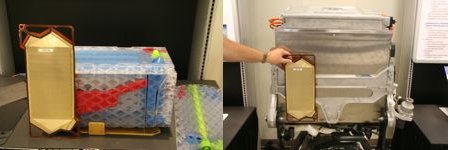A plastic mock-up of the GM Gen5 fuel cell stack
General Motors built the first fuel cell-powered vehicle back in the 1960s when they created ElectroVan, a concept that was only tested briefly before being shelved. Over the past decade however, the company has worked aggressively to develop fuel cell technology. Last spring when they showed off the fuel cell variant of the Chevy Volt at the Shanghai Motor Show, they also announced their fifth-generation fuel cell stack.
At the time, VP of R&D Larry Burns discussed the new stack but didn't give much detail. The focus of the new design was on dramatically reducing the cost while improving the power density. One of the improvements that was mentioned was catalyst thrifting. This involves improved methods of applying the catalyst materials to ensure thinner, more uniform surfaces. This reduces the total amount of catalyst material that's required while allowing it to be more effective.
Update: At General Motors request two photos were removed from the gallery.
Continue reading about the Gen5 stack after the jump.

The Gen5 stack on the left with a bipolar plate, the Equinox Gen4 on the right
The Gen4 stack that was used in the Chevy Sequel concept and also in the new Equinox fuel cell was designed as an experimental prototype system. That means most of the parts are individually produced with the case itself being assembled from many machined components. In the early decades of the auto industry, engines were produced in much the same way with individually machined cylinders being mated to crankcases, water jackets and cylinder heads.
Eventually they developed casting methods that allowed cylinder blocks to be cast as a single unit that could then be finish machined. This drastically reduced the cost of manufacturing engines. This type of manufacturing technology is now being applied to the Gen5 fuel cell. The new cast case includes integrated passages for fuel and coolant. The Gen4 stack had most of its cooling and fuel system plumbing hand built on the outside of the stack. Most of that duct-work is now inside resulting in a major decrease in assembly time. This internal ducting can be seen in the colored parts of the Gen5 mock-up that was on display.

All of these design changes result in near doubling of power density to 3kW/L and 2kW/kg. By comparison the latest Honda vertical flow stack in the FCX concept only achieves 2kW/L and 1.5kW/kg. An 80kW Gen5 stack is about half the size of a similar power stack in the Equinox or Sequel. The changes to the catalyst application also nearly double the efficiency of the stack allowing a vehicle like the Sequel which took over 7kg of hydrogen to go 300 miles to now cover that distance on 4kg.
All these advances are part of GM's effort to get the cost of the fuel cell system down to $50/kW for volume production within the next two years. GM has prototypes of the Gen5 stack running and Volt prototypes using the new system will probably hit the track some time next year after the flex-fuel range extender is running.


Sign in to post
Please sign in to leave a comment.
Continue